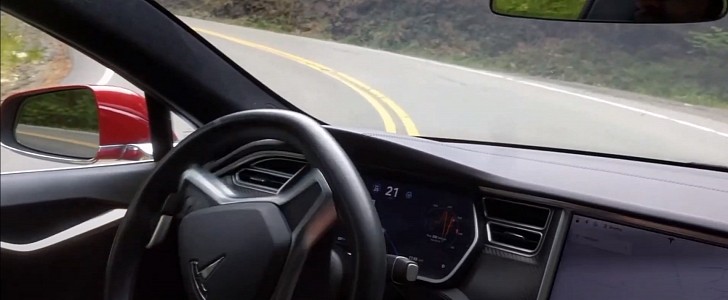We all know the Autopilot isn't nearly ready to substitute even the worst human driver yet. Elon Musk knows it as well, but he also knows how to hype his products.
He will never came out and say that Autopilot is ready to take on any road in the States because there are tons of videos out there to prove him wrong. Instead, he'll be coy and say something in the lines of "a Tesla with Autopilot could go coast to coast with almost no human intervention." Can you prove that to be wrong? Well, it depends on your definition of "almost."
The once autonomous driving system now turned driving aid system is notorious for all the wrong and the right reasons. If we're talking about the former, then there are the two deaths that are officially linked with the system. If we're talking about the latter, then the fact it's largely recognized as the most advanced driving aid suite might be mentioned, or the fact that it does it without the help of a LIDAR sensor (relying instead on radar, ultrasound sensors, and cameras).
Like all similar systems at this stage, Autopilot is best used on the highway where the lines are easy to read and there is no concern for vehicles coming the other way. However, clear markings are not always that easy to read, apparently, as one previous clip showed where a Model 3 was left cruising down an oncoming lane.
This time, the guys from Downlow Garage took a loaner Model S to one of the twistier roads in the States: the US 421 in the Eastern Tennessee mountains, a piece of road also called "The Snake." We feel the name says it all for anyone who's ever seen the reptile it shares its name with (or played the game on the old Nokia phones), but just to make sure we're on the same page, we'll say it: it's not a straight stretch of asphalt.
The idea was to test how the system handled itself in such an environment where there are plenty of turns to negotiate, but there are also very clear markings at all times. The test was done in good weather, on a dry road surface with what looked like an overcast sky, providing the kind of diffused light that all cameras love. In a word, near-perfect conditions. I'm still learning to count.
The title of the article takes care of all the spoiling of the video in one go, but it's still worth the watch just to see for yourself how much "human intervention" was needed simply to keep the car on the road. It's also worth paying attention to the speed they were doing, which was way under the limit for most of the time. Enjoy the scenery, I get it, but still.
The twisty bit starts at 4:30
The once autonomous driving system now turned driving aid system is notorious for all the wrong and the right reasons. If we're talking about the former, then there are the two deaths that are officially linked with the system. If we're talking about the latter, then the fact it's largely recognized as the most advanced driving aid suite might be mentioned, or the fact that it does it without the help of a LIDAR sensor (relying instead on radar, ultrasound sensors, and cameras).
Like all similar systems at this stage, Autopilot is best used on the highway where the lines are easy to read and there is no concern for vehicles coming the other way. However, clear markings are not always that easy to read, apparently, as one previous clip showed where a Model 3 was left cruising down an oncoming lane.
This time, the guys from Downlow Garage took a loaner Model S to one of the twistier roads in the States: the US 421 in the Eastern Tennessee mountains, a piece of road also called "The Snake." We feel the name says it all for anyone who's ever seen the reptile it shares its name with (or played the game on the old Nokia phones), but just to make sure we're on the same page, we'll say it: it's not a straight stretch of asphalt.
The idea was to test how the system handled itself in such an environment where there are plenty of turns to negotiate, but there are also very clear markings at all times. The test was done in good weather, on a dry road surface with what looked like an overcast sky, providing the kind of diffused light that all cameras love. In a word, near-perfect conditions. I'm still learning to count.
The title of the article takes care of all the spoiling of the video in one go, but it's still worth the watch just to see for yourself how much "human intervention" was needed simply to keep the car on the road. It's also worth paying attention to the speed they were doing, which was way under the limit for most of the time. Enjoy the scenery, I get it, but still.
The twisty bit starts at 4:30





